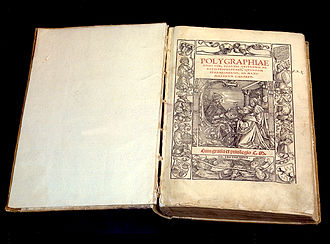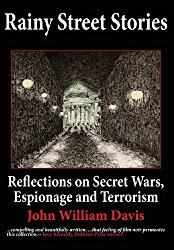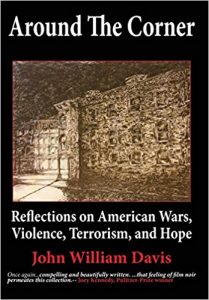Article by John Davis

Who must keep secrets? We’d all agree spies, diplomats, and government leaders would, of course. Then there are lovers, religious groups, and businessmen who must keep their dealings private. All of these share a need for codes and cyphers. Where and when did they begin to formalize these secret communication practices? The art of cryptography has a fascinating background, and its development is truly itself a matter of wonder.
Books dealing in secret cypher techniques appeared in Europe early in the age of printing. Why? Private codes had existed forever, but were difficult to implement. You and I might share a code, but to share it with others over long distances proved problematic. Sharing on a broad basis, with many others, across lands and seas was even more difficult. With the advent of Gutenberg’s printing press, in the early 1400’s, codes became even more urgent. Here was a capability to communicate with many specific people, using the same encrypted message which they alone knew.
While almost every school child knows of Gutenberg, few know of Johannes Trithemeus. He was also a German, the author of Steganographia. This book was a description of some 55 types of code, and listed many ways they could be arranged to send messages to secret counterparts. While it is believed this book was written about 1500, its publication was stopped. It wasn’t stopped because the ulterior notion of secret communication was objectionable. Rather, the local worthies of the day believed it was sacrilegious, because it used magical symbols, cabalistic occult plates, and similar inexplicable designations for letter substitution! Only some years later when Trithemeus wrote Poligraphiae, with the offending symbols omitted, did he achieve publication.
Like lightening, this code book was translated into French and Spanish, the great empires of the day. Not to be outdone, an existing cypher document from William, Sixth Lord Pagett of Beaudesert showed how the English engaged in secret communications with gusto. His printed code sheet from 1699 reveals how he posted secret memos back home from his postings in Vienna and Constantinople. The long voyage from outposts of empire, across dangerous seas and even more difficult land routes, demanded that such communications not fall into the wrong hands. Cryptography insured this.
Giambattista Porta, of the Kingdom of Naples, was perhaps the first to write a history of cryptography going back to ancient times. His ideas influenced the Papal States and even Blaise de Genere, a Frenchman. Both used the study of enciphering to great advantage in their lifetimes.
Most fascinating of all early cryptographers has to be John Wilkins, an English bishop who came up with the idea of hiding secret messages in musical notes. He outlined this idea in his late 17th Century book, Mercury, The Secret and Swift Messenger. This ingenious method was expanded upon by Phillip Thicknesse, writing about the ‘harmonic alphabet’. In his 1772 book, A Treatis on the Art of Decyphering and of Writing in Cypher, Thicknesse proposed hiding messages in musical scores as the least suspicious method of conveying secrets. All of this would have been a quaint historical anecdote had it not been for an intrepid St. Louisan, who took French citizenship in 1937, before World War II.
Josephine Baker was an African American dancer of tremendous popularity in Europe before the Second World War. She took Paris by storm, dancing to modern Jazz music in artistic fashions ranging from banana skirts to chic Parisian modes. Her popularity brought her to every social circle in the city; she was the toast of embassies, social clubs, and salons of the upper classes. Josephine was also a spy. She gathered an immense amount of information from talkative generals, ambassadors, and the social elite.
She delivered this intelligence through messages secreted in her sheet music. As an entertainer of international renown, she was allowed to travel throughout neutral Europe, even after the Germans took over Paris. Information she provided on German harbor activities, secret troop maneuvers, and locations of ammunition and supply depots was of immense value to the Allied cause. She received, as a consequence of her efforts, the Rosette de la Resistance and Croix de Guerre from the Free French government. Ms. Baker went on to become a great advocate of Civil Rights.
Cyphers and codes have always been with us, but the advent of the printing press propelled them to greater heights of complexity. Luckily for all the world, not only for those who use codes to hide true meanings, Francesco Lana Terzi discovered an even greater use of alternate alphabetization.
Lana Terzi’s 1670 book, Prodomo, proposed another great use for letter and number substitution codes. They could be employed for teaching the deaf to speak, and the blind to read! Perhaps Helen Keller’s great revelation at the water faucet with her teacher Annie Sullivan might never have come along had it not been for students of secret codes!
~ Article by John Davis
Read More from John

John William Davis is a retired US Army counterintelligence officer and linguist. As a linguist, Mr. Davis learned five languages, the better to serve in his counterintelligence jobs during some 14 years overseas. He served in West Germany, Italy, and the Netherlands during the Cold War. There he was active in investigations directed against the Communist espionage services of the Soviet Union and Warsaw Pact. His mission was also to investigate terrorists such as the Red Army Faction in Germany, the Red Brigades in Italy, and the Combatant Communist Cells (in Belgium) among a host of others.
His work during the Cold War and the bitter aftermath led him to write Rainy Street Stories, ‘Reflections on Secret Wars, Terrorism, and Espionage’ . He wanted to talk about not only the events themselves, but also the moral and human aspects of the secret world as well.

And now recently published in 2018, John continued his writing with Around the Corner: Reflections on American Wars, Violence, Terrorism, and Hope.
Two powerful books worth reading.
Read more about them in the following Six Questions:
Six Questions with John Davis: Author of Rainy Street Stories
Six Questions with John Davis: Author of Around the Corner
.
.
.
